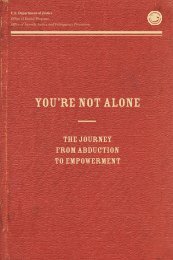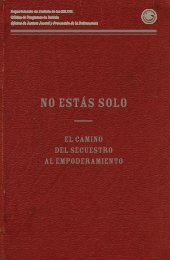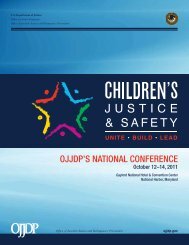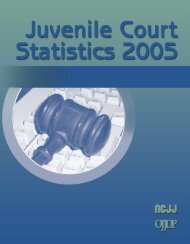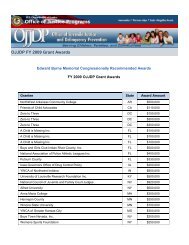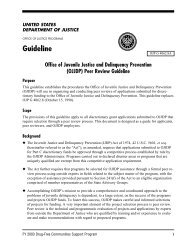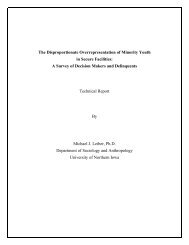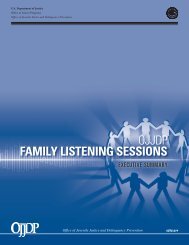Promising Strategies To Reduce Gun Violence - Office of Juvenile ...
Promising Strategies To Reduce Gun Violence - Office of Juvenile ...
Promising Strategies To Reduce Gun Violence - Office of Juvenile ...
You also want an ePaper? Increase the reach of your titles
YUMPU automatically turns print PDFs into web optimized ePapers that Google loves.
Pr<strong>of</strong>ile No. 2 (continued)<br />
neighborhoods. Probation <strong>of</strong>ficers introduced<br />
researchers to a sample <strong>of</strong> young<br />
probationers who were interviewed in focus<br />
groups or individually in winter 1994 and<br />
summer 1995. Many <strong>of</strong> the juveniles said<br />
they had guns for self-defense and joined<br />
gangs for protection.<br />
The main thrust <strong>of</strong> the KSG analysis consisted<br />
<strong>of</strong> geographical mapping over the<br />
summer <strong>of</strong> 1995. The working group <strong>of</strong><br />
practitioners pooled their knowledge and<br />
provided the researchers with information<br />
on gang size, turf, alliances, and conflicts.<br />
They also classified 5 years <strong>of</strong> youth homicide<br />
victimization data and tied it to gangs.<br />
Boston had 61 gangs with about 1,300 members<br />
from 4 neighborhoods; these groups<br />
committed 60 percent or more <strong>of</strong> the youth<br />
homicides in the city. Based on this information,<br />
researchers constructed a territorial<br />
map <strong>of</strong> the identified gangs, containing<br />
practitioners’ estimates <strong>of</strong> membership size<br />
and sociograms <strong>of</strong> alliances and antagonisms.<br />
This territorial map identified which<br />
gangs should be targeted in order to disrupt<br />
key sources <strong>of</strong> conflict. Network analysis<br />
also led to strategies to communicate a deterrence<br />
message to targeted gangs by identifying<br />
cliques that would, in turn, be most<br />
efficient at getting that message out to the<br />
largest number <strong>of</strong> gang members.<br />
The researchers were fortunate in having<br />
access to a very rich gun data set from the<br />
Bureau <strong>of</strong> Alcohol, <strong>To</strong>bacco and Firearms<br />
(ATF). Every gun that had been used in a<br />
crime and which had come into police hands<br />
since 1991 had been traced and included in<br />
the ATF data set. Out <strong>of</strong> 1,550 records <strong>of</strong><br />
guns from youth ages 21 and under, 809<br />
were traceable to Federal firearm licensees,<br />
first retail purchases, or both. ATF analyzed<br />
the type, caliber, make, geographic origin,<br />
and “time-to-crime” age for each gun; the<br />
proportion <strong>of</strong> guns with obliterated serial<br />
numbers; the number <strong>of</strong> guns that had been<br />
used in substantive crimes versus those<br />
seized by police on possession charges; and<br />
adult versus youth gun patterns. In addition,<br />
ATF determined that at least half <strong>of</strong> the<br />
guns came from very small and infrequent<br />
purchases by straw purchasers and that<br />
these purchasers rarely received law enforcement<br />
attention. Interviews with youth<br />
confirmed the belief that guns were readily<br />
available to them—through illegal purchase<br />
or borrowing. A gang might have only a few<br />
guns, but they were available to all members.<br />
Contrary to common belief, youth<br />
shunned guns that had been used in burglaries<br />
because they knew that the weapons<br />
had been used in other crimes and did not<br />
want to be held responsible.<br />
The supply-side research dispelled the generally<br />
held belief that Boston youth gangs<br />
obtained their guns from southern States<br />
with lax gun laws. Contrary to expectations,<br />
34 percent <strong>of</strong> traceable guns were first sold<br />
at retail in Massachusetts and close to 15<br />
percent were from nearby New England<br />
States. Most <strong>of</strong> the guns recovered were<br />
handguns and semiautomatic pistols. Semiautomatic<br />
weapons had the shortest “timeto-crime”:<br />
more than 40 percent were less<br />
than 2 years old. Serious crimes typically<br />
involved more shotguns, more in-State<br />
guns, and fewer obliterated serial numbers<br />
than guns associated with the possession<br />
charges <strong>of</strong> less serious youth <strong>of</strong>fenders. In<br />
summary, the supply-side analyses indicated<br />
that new guns were coming into the youth<br />
illicit market at close to first retail sale.<br />
Law enforcement strategies<br />
Operation Ceasefire<br />
Operation Ceasefire is a coordinated<br />
citywide strategy established in May 1996<br />
to deter youth firearm violence. Ceasefire<br />
operates as a system, focusing interventions<br />
28 <strong>Promising</strong> <strong>Strategies</strong> <strong>To</strong> <strong>Reduce</strong> <strong>Gun</strong> <strong>Violence</strong>



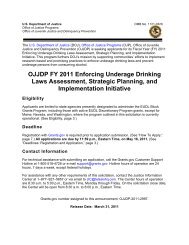
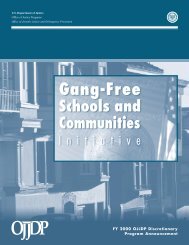
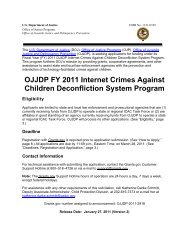
![Chapter 5 [PDF] - Office of Juvenile Justice and Delinquency ...](https://img.yumpu.com/46584340/1/190x245/chapter-5-pdf-office-of-juvenile-justice-and-delinquency-.jpg?quality=85)

